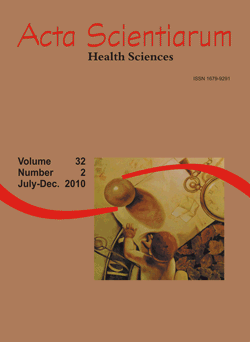<b>Effect of ultrasound associated with calendula gel on restorative activity in experimental muscular injuries</b> - doi: 10.4025/actascihealthsci.v32i2.4626
Keywords:
Ultrasound, Calendula officinalis, phonophoresis, front tibial muscle
Abstract
Several techniques have been proposed as treatment for muscular injuries, and therapeutic ultrasound is one of the most used. Besides the effects of ultrasound, it also facilitates drug flow trough the tissues (phonophoresis). Calendula is a phytotherapic which presents healing elements, popularly used on injury treatments. The objective of this study was to evaluate ultrasound effectiveness, phonophoresis, and the influence of the topic application of the gel with Calendula officinalis extract, in the recovery from experimental muscular injury in rats. After the injured front tibial muscle was treated during five days, a histological analysis of the muscle was performed and the injury area was determined. The results indicated that all the ultrasound/Calendula-treated groups presented better evolution in the injury, sinasce they presented more fibroblasts, neovascularization and myoblasts in relation to the control group. As to the injured area, only the group in which the ultrasound was added to Calendula presented a significantly smaller area. In all, the obtained data demonstrate that in the experimental model studied, phonophoresis was more indicated for muscle injury treatment.Downloads
Download data is not yet available.
Published
2010-09-28
How to Cite
Ricoldy, D. da S., Botura, A. C. de A., Oda, J. Y., & Takemura, O. S. (2010). <b>Effect of ultrasound associated with calendula gel on restorative activity in experimental muscular injuries</b> - doi: 10.4025/actascihealthsci.v32i2.4626. Acta Scientiarum. Health Sciences, 32(2), 135-140. https://doi.org/10.4025/actascihealthsci.v32i2.4626
Issue
Section
Health Sciences
DECLARATION OF ORIGINALITY AND COPYRIGHTS
I Declare that current article is original and has not been submitted for publication, in part or in whole, to any other national or international journal.
The copyrights belong exclusively to the authors. Published content is licensed under Creative Commons Attribution 4.0 (CC BY 4.0) guidelines, which allows sharing (copy and distribution of the material in any medium or format) and adaptation (remix, transform, and build upon the material) for any purpose, even commercially, under the terms of attribution.
Read this link for further information on how to use CC BY 4.0 properly.























5.png)







